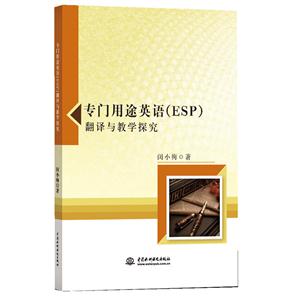
作者:(英)Laurence Anthony著
页数:21,219页
出版社:外语教学与研究出版社
出版日期:2022
ISBN:9787521337235
电子书格式:pdf/epub/txt
内容简介
本书共10章,分为三部分。第一部分介绍了ESP产生的背景、基本概念、发展历史及其在英语语言教学中的地位和作用,指出了语言学者在当前全球化进程中所面临的挑战。第二部分对ESP的“四大支柱”,即需求分析、学习目标、素材与方法、评价,行了详细的论述。第三部分探讨了ESP的实践,包括在不同场景和语境中ESP教师所使用的教学方法、在ESP教学过程中教师和管理者所面临的挑战以及如何应对这些挑战、ESP未来的发展方向。
作者简介
劳伦斯·安东尼,供职于早稻田大学科学与工程学院,应用语言学领域教授。曾任科学与工程英语教育中心主任,并在学术界和工业界创建了大规模的ESP项目。
本书特色
华大学资深教师团队研发的精品慕课,借助多媒介、多形态、多层次的教学手段,最大限度地满足教师的教学需要.
目录
总序
导读
Figures
Tables
Acknowledgments
Introduction:How to use this book
1 Target readers
2 Assumptions
3 Overview of the contents
4 Features of the chapters
5 HOWto usethe book
6 Final notes
Section 1 Contextualizim,ESP
Chapter 1 Situating ESP in English language teaching and learning
1 Commentary
2 A definition of ESP
3 Branches of ESP
4 Characteristic features of ESP
5 Complementing and competing approaches to ESP
6 Contentious issues in ESP:absolute and variable characteristics
7 Further resources
Chapter 2 Situating ESP in the world at large
1 Commentary
2 The growth of English as a world-wide lingua franca
3 ESP in today’s globalized economy
4 ESP in today’s globalized world of academia
5 Positioning of ESP in occupational and academic settings
6 Contentious issues in ESP:is the globalization of English a good thing?
7 Further resources
Chapter 3 Introducing the four pillars of ESP
1 Commentary
2 The fourpillars of ESP
3 The roles of learners,instructors,and administrators in ESP
4 Contentious issues in ESP:who should teach ESP?
5 Further resources
Section 2 Understanding the four pillars of ESP
Chapter 4 Identifying needs in the design of ESP courses and programs
1 Commentary
2 Basic concepts in needs analysis
3 Conducting a large-scale,detailed needs analysis
4 Conducting a small-scale just in time needs analysis
5 Evaluating fl needs analysis
6 Contentious issues in ESP:isn’t a learner survey enough?
7 Further resources
Chapter 5 Deciding learning objectives for ESP courses and programs
1 Commentary
2 Foundations for deciding learning objectives
3 Sequencing of learning objectives
4 Contentious issues in ESP:addressing the subject knowledge problem
5 Further resources
导读
Figures
Tables
Acknowledgments
Introduction:How to use this book
1 Target readers
2 Assumptions
3 Overview of the contents
4 Features of the chapters
5 HOWto usethe book
6 Final notes
Section 1 Contextualizim,ESP
Chapter 1 Situating ESP in English language teaching and learning
1 Commentary
2 A definition of ESP
3 Branches of ESP
4 Characteristic features of ESP
5 Complementing and competing approaches to ESP
6 Contentious issues in ESP:absolute and variable characteristics
7 Further resources
Chapter 2 Situating ESP in the world at large
1 Commentary
2 The growth of English as a world-wide lingua franca
3 ESP in today’s globalized economy
4 ESP in today’s globalized world of academia
5 Positioning of ESP in occupational and academic settings
6 Contentious issues in ESP:is the globalization of English a good thing?
7 Further resources
Chapter 3 Introducing the four pillars of ESP
1 Commentary
2 The fourpillars of ESP
3 The roles of learners,instructors,and administrators in ESP
4 Contentious issues in ESP:who should teach ESP?
5 Further resources
Section 2 Understanding the four pillars of ESP
Chapter 4 Identifying needs in the design of ESP courses and programs
1 Commentary
2 Basic concepts in needs analysis
3 Conducting a large-scale,detailed needs analysis
4 Conducting a small-scale just in time needs analysis
5 Evaluating fl needs analysis
6 Contentious issues in ESP:isn’t a learner survey enough?
7 Further resources
Chapter 5 Deciding learning objectives for ESP courses and programs
1 Commentary
2 Foundations for deciding learning objectives
3 Sequencing of learning objectives
4 Contentious issues in ESP:addressing the subject knowledge problem
5 Further resources















